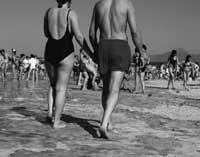Sun baths against psoriasis
also characterized by flaking of the skin, on which thick plates of crust form. The appearance of these injuries causes many patients to be embarrassed, in many cases until total isolation, as they do not even dare to go out into the street.
No wonder. In our society physical appearance has so much importance and influence, so the accounts are quite silent for those affected by psoriasis. The affected skin is less aesthetically pleasing and therefore often try to hide from the eyes of others. However, it is not a contagious disease, nor a bad cleaning or hygiene, but a cellular problem.
Wedge is found in cell growth
The dermatologist Montserrat Pérez, member of the Spanish Society of Dermatology, explains that psoriasis is a chronic skin disorder characterized by cellular hyperproductivity, an epidermal cell that reproduces normally every 30 days and lasts only four days in a person subjected to psoriasis.
The proliferation of cells in the outermost layer of the skin, called epidermis, is very rapid and, not having enough time to flap or fall as usual, results in reddish plaques covered with white scales. Red means more blood accumulates in this area than normal, while white scales or plaques are skin cells that have not been able to fall or flap.

In most cases, psoriasis appears in elbows, knees, scalp, or nails, but can appear anywhere on the body, even covering the entire body surface.
Psoriasis is a genetic disease, so the inheritance inherited from our ancestors is of great importance. This does not mean, of course, that the descendants of the psoriatic person necessarily suffer the disease, since they may never suffer symptoms. Currently, the incidence of the disease is 2% worldwide, and we know that if a partner has psoriasis, one in eight children of that partner can inherit it it, but if both are psoriatic (father and mother together) the probability is double (one in four children).
In most cases, this hereditary burden does not have enough weight to show the disease and it is necessary to have some external factor as an auxiliary factor. The most common triggers for psoriasis are:
- Infections, mainly from streptococcus, but also flu, streaks and other upper respiratory infections.
- Alcohol. Although it has not yet been fully clarified, alcoholic beverages have been shown to worsen or launch the disease.
- Obesity. Overweight people are more likely to suffer from psoriasis.
- Nervous stress. Often, pathology manifests itself in a time of severe anxiety or physical or psychological stress.
- Hormonal changes, especially in puberty, postpartum, or menopause.
- Some medicines. For example, lithium compounds prescribed for the treatment of depressions; antimalaria drugs; gold salts, usually given to patients with arthritis; and beta-blockers, prepared to combat high blood pressure and angina.
Classification
Not all psoriasis are the same. Different classifications may be made, depending on the lesions seen or the part of the body in which they appear.
It is the most common. Reddish plates appear (especially on elbows and knees) covered with white scales.
It is usually seen in children and young people, usually after infection of the upper respiratory tract. As the name suggests, injuries are small spots or drops that take arms, legs, or trunk.
* Psoriasis scalp
The scales that cover the plates are pearly and the greatest difficulty is to make a discriminatory diagnosis with seborrheic eczema.
Common in armpits or armpits, under the chest (for women) or in English. In these cases, inflammation appears, but no scales accumulate.
If it does not appear in other areas, the diagnosis may go unnoticed.
Several yellowish brown spots or spots appear, as if they were oil spots. This type of psoriasis can cause a complication called psoriatic arthritis, which is joint pain.
From another point of view, and taking into account the nature of the lesions, it is worth differentiating:
a) Erythrodermal psoriasis: is the most serious type of psoriasis, but fortunately the most rare. Redness and subsequent flaking appear throughout the body.
b) Pustular psoriasis, in which the lesions are injured, loaded with pus.
Treatment
The treatments used today are many and varied, since it is about individualizing the case of each patient to achieve greater effectiveness.
Light treatments (natural and/or artificial light) and treatments with oral medications are usually topical treatments (special moisturizing creams).
Sunbathing in 80% of psorians is very beneficial, always with the prior measure of protecting the most delicate parts of the body. When you opt for a certain treatment, the doctor intends to stop cell hyperactivity and the sun is highly recommended, since what you get is "burn" the skin and, ultimately, release the psoriatic and fall.
To achieve a similar effect, phototherapy and photoperiotherapy are used, that is, ultraviolet light (similar to that of the sun) is applied but it is applied by special machines.
It must be said, like any other chronic disease, that psoriasis is not cured, but we can manage it and whiten the affected areas. Many people affected by psoriasis have managed to have long seasons without any symptoms.
Buletina
Bidali zure helbide elektronikoa eta jaso asteroko buletina zure sarrera-ontzian











